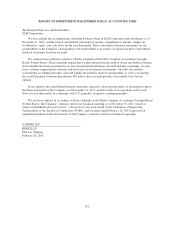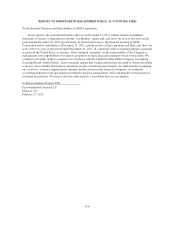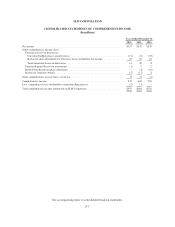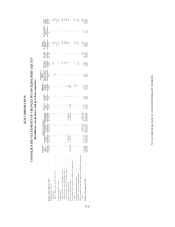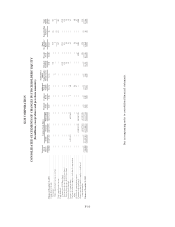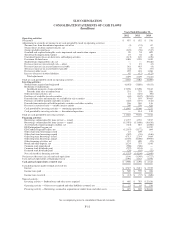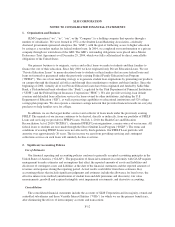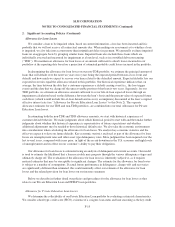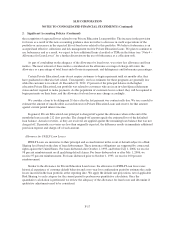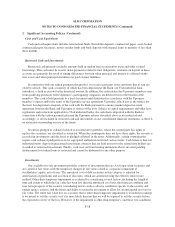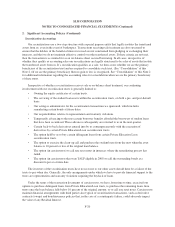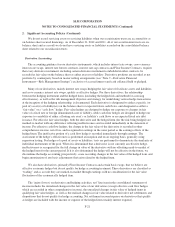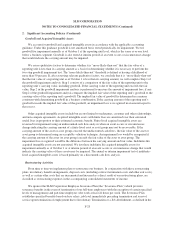Sallie Mae 2012 Annual Report Download - page 123
Download and view the complete annual report
Please find page 123 of the 2012 Sallie Mae annual report below. You can navigate through the pages in the report by either clicking on the pages listed below, or by using the keyword search tool below to find specific information within the annual report.SLM CORPORATION
NOTES TO CONSOLIDATED FINANCIAL STATEMENTS (Continued)
2. Significant Accounting Policies (Continued)
We consolidate any VIEs where we have determined we are the primary beneficiary. The primary
beneficiary is the entity which has both: (1) the power to direct the activities of the VIE that most significantly
impact the VIE’s economic performance and (2) the obligation to absorb losses or receive benefits of the entity
that could potentially be significant to the VIE. As it relates to our securitized assets as of December 31, 2012,
we are the servicer of the securitized assets and own the Residual Interest of the securitization trusts. As a result,
we are the primary beneficiary of our securitization trusts and consolidate those trusts.
Fair Value Measurement
We use estimates of fair value in applying various accounting standards for our financial statements. Fair
value measurements are used in one of four ways:
• In the consolidated balance sheet with changes in fair value recorded in the consolidated statement of
income;
• In the consolidated balance sheet with changes in fair value recorded in the accumulated other
comprehensive income section of the consolidated statement of changes in stockholders’ equity;
• In the consolidated balance sheet for instruments carried at lower of cost or fair value with impairment
charges recorded in the consolidated statement of income; and
• In the notes to the financial statements.
Fair value is defined as the price to sell an asset or transfer a liability in an orderly transaction between
willing and able market participants. In general, our policy in estimating fair value is to first look at observable
market prices for identical assets and liabilities in active markets, where available. When these are not available,
other inputs are used to model fair value such as prices of similar instruments, yield curves, volatilities,
prepayment speeds, default rates and credit spreads (including for our liabilities), relying first on observable data
from active markets. Depending on current market conditions, additional adjustments to fair value may be based
on factors such as liquidity, credit, and bid/offer spreads. Transaction costs are not included in the determination
of fair value. When possible, we seek to validate the model’s output to market transactions. Depending on the
availability of observable inputs and prices, different valuation models could produce materially different fair
value estimates. The values presented may not represent future fair values and may not be realizable.
We categorize our fair value estimates based on a hierarchical framework associated with three levels of
price transparency utilized in measuring financial instruments at fair value. Classification is based on the lowest
level of input that is significant to the fair value of the instrument. The three levels are as follows:
• Level 1 — Quoted prices (unadjusted) in active markets for identical assets or liabilities that we have
the ability to access at the measurement date. The types of financial instruments included in level 1 are
highly liquid instruments with quoted prices.
• Level 2 — Inputs from active markets, other than quoted prices for identical instruments, are used to
determine fair value. Significant inputs are directly observable from active markets for substantially the
full term of the asset or liability being valued.
• Level 3 — Pricing inputs significant to the valuation are unobservable. Inputs are developed based on
the best information available. However, significant judgment is required by us in developing the
inputs.
F-13


